Gumiera: Morocco Berbers in French military service
After the Reconquista came the turning point and from the XV-XVI centuries. The territory of North Africa, including the Moroccan coast, became the object of the colonial interests of the European powers. Initially, the Moroccan ports were interested in Spain and Portugal - the two main rival European sea powers, especially located in close proximity to the North African coast. They managed to conquer the ports of Ceuta, Melilla and Tangier, occasionally making raids also into the depths of Morocco.
Then, with the strengthening of their positions in world politics and the transition to the status of colonial powers, the British and French became interested in the territory of Morocco. Since the turn of the XIX-XX centuries. most of the lands of North-West Africa were in the hands of the French, between England and France in 1904 a contract was concluded, according to which Morocco was attributed to the sphere of influence of the French state (in turn, the French abandoned claims to Egypt, which the years are tightly "fallen" under the English influence).
Colonization of Morocco and the creation of the Gumières
Nevertheless, the French colonization of Morocco came relatively late and had a slightly different character than in the countries of Tropical Africa or even neighboring Algeria. Much of Morocco’s territory fell into orbit of French influence between the 1905-1910 years. In many ways, this was supported by the attempt of Germany, which gained strength during this period and sought to acquire as many strategically important colonies as possible, to establish itself in Morocco, promising full support to the Sultan.
Despite the fact that England, Spain and Italy agreed with the “special rights” of France to Moroccan territory, Germany until the last time put up obstacles to Paris. So, Morocco did not fail to visit even the Kaiser Wilhelm himself. At that time, he was nurturing plans for expanding German influence specifically on the Muslim East, with the aim of which he established and developed allied relations with Ottoman Turkey and tried to extend German influence to territories inhabited by Arabs.
In an effort to consolidate their positions in Morocco, Germany convened an international conference that lasted from January 15 to April 7 April 1906, but only Austria-Hungary supported the Kaiser, the rest of the states supported the French position. Kaiser was forced to retreat, because he was not ready for open confrontation with France and, especially, with its many allies. Germany's repeated attempt to oust the French from Morocco referred to the 1910-1911. and also ended in failure, despite the fact that the Kaiser even sent a gunboat to the shores of Morocco. 30 March 1912, the Fez Treaty was signed, under which France established a protectorate over Morocco. Germany also benefited slightly from it - Paris shared with the Kaiser part of the territory of the French Congo, where the German colony of Cameroon originated (however, the Germans did not possess it for long - already in 1918, all the colonial possessions of Germany that lost World War I were divided between the Entente countries).
The history of the Gumier units, which will be discussed in this article, began just between two Moroccan crises - in the 1908 year. Initially, France sent troops into Morocco, staffed, including by Algerians, but quickly decided to move to the practice of recruiting support units from among the local population. As in the case of the Zouaves, the look of the French generals fell on the Berber tribes that inhabited the Atlas Mountains. The Berbers, the indigenous inhabitants of the Sahara, retained their language and particular culture, which was not completely destroyed even despite the millennial Islamization. Morocco still has the largest percentage of the Berber population in comparison with other countries in North Africa - representatives of the Berber tribes make up 40% of the country's population.
The modern name "Berbers", by which we know people who call themselves "amakhag" ("free man"), comes from an ancient Greek word meaning "barbarians". Since ancient times, the Berber tribes inhabited the territory of modern Libya, Algeria, Tunisia, Morocco, Mauritania, the northern regions of Niger, Mali, Nigeria and Chad. In terms of language, they belong to the Berber-Libyan subfamily, which is part of the Afro-Asiatic linguistic macro-family, along with Semitic languages and a number of languages of African peoples.
Today, the Berbers are Sunni Muslims, but many tribes retain obvious remnants of ancient pre-Islamic beliefs. The territory of Morocco is inhabited by two main groups of Berbers - Shilla, or Shleh, living in the south of the country, in the Atlas Mountains, and Amazirgi, inhabiting the Rifian Mountains in the north of the country. It was precisely the Amacirghi in the Middle Ages and the New Age that stood at the source of the famous Moroccan piracy, making raids on Spanish villages on the opposite coast of the Mediterranean.
The Berbers were traditionally distinguished by militancy, but above all they attracted the attention of the French military command of their high adaptability to the difficult conditions of life in the mountains and deserts of the Maghreb. In addition, the land of Morocco was for them native and recruiting soldiers from among the Berbers, the colonial authorities received excellent scouts, gendarmes, guards who knew all the mountain trails, ways to survive in the desert, traditions of the tribes with whom to fight, etc.
The founding father of the Moroccan Gumières can rightly be considered General Albert Amad. In 1908, this fifty-two-year-old brigadier general commanded the expeditionary force of the French army in Morocco. It was he who proposed the use of Moroccan subsidiary units and opened the recruitment of Berbers from representatives of various tribes who inhabited Morocco’s territory - mainly the Atlas Mountains (since another area of Berber’s compact residence, Reef Mountains - was part of Spanish Morocco).
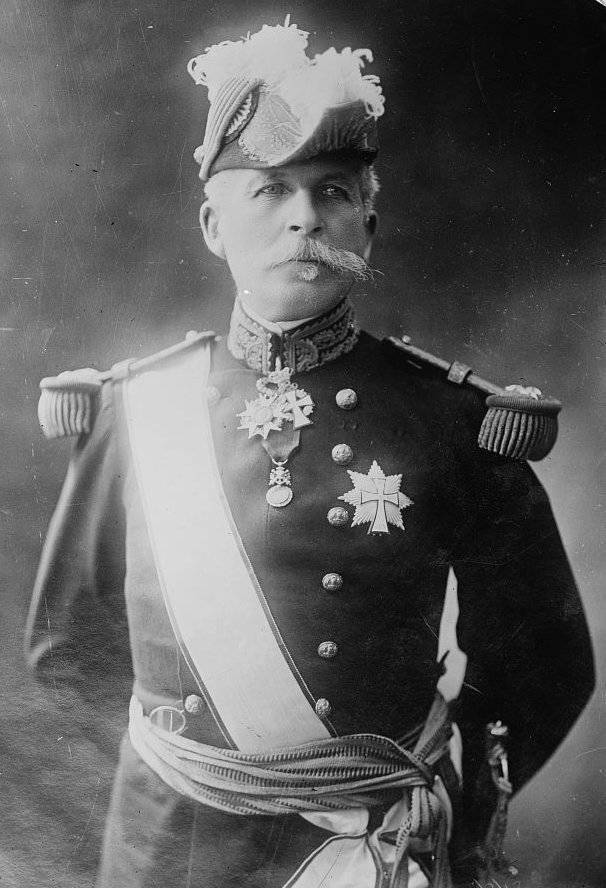
It should also be noted that although some subdivisions that were formed and served in the Upper Volta and Mali (French Sudan) were called Gummeras, the Moroccan Gummeres became the most numerous and well-known.
Like other divisions of the colonial troops, the Moroccan Gumeres were originally created under the command of French officers seconded from parts of the Algerian spags and shooters. Somewhat later, the practice of nominating Moroccans to non-commissioned officers began. Formally, the Gumeres were subordinate to the King of Morocco, but in fact they performed all the same functions of the French colonial troops and participated in almost all the armed conflicts that France led in 1908-1956. - during the protectorate of Morocco. The duties of the Gumiers at the very beginning of their existence included patrolling Moroccan territories occupied by the French and conducting reconnaissance against rebellious tribes. After the official status of military units was given to the Gumiera in 1911, they switched to the same service as the other French military units.
From other divisions of the French army, including the colonial one, the Gumeres were distinguished by greater independence, manifested, among other things, in the presence of special military traditions. Gummere traditional Moroccan clothing was preserved. Initially, they generally wore a tribal costume - most often, turbans and blue cloaks, but then their uniforms were streamlined, although they retained key elements of the traditional costume. The Moroccan Gummeres were instantly recognized by their turbans and gray striped or brown “djellaba” (hooded cloak).
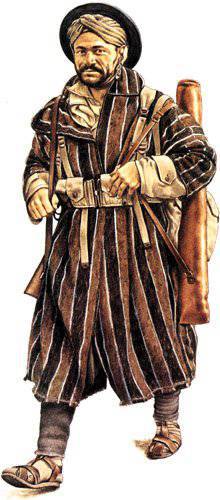
National sabers and daggers were also left in service with the Gumiers. By the way, it was the curved Moroccan dagger with the letters GMM that became the symbol of the Moroccan Gumières subdivisions. The organizational structure of the units completed by Moroccans also had some differences. Thus, the base unit was a “gum”, equivalent to a French company and numbering Gumiers before 200. Several "gums" were united in a "camp", which was an analogue of the battalion and was the main tactical unit of the Moroccan Gumières, and groups were formed from the "camps". The Gumier units were commanded by French officers, but the lower ranks were almost completely recruited from among the representatives of the Berber tribes of Morocco, including the highlanders of the Atlas.
The first years of their existence, the Gumier units were used in Morocco to protect French interests. They carried a garrison guard duty, used for quick raids against hostile tribes prone to insurgency. That is, in fact, they carried the gendarme service rather than the service of the ground forces. Throughout 1908-1920. Gumier units played an important role in the implementation of the “pacification” policy of Moroccan tribes.
Reef war
They showed themselves most actively during the famous Reef War. Recall that, according to the Fez 1912 Treaty, Morocco fell under a French protectorate, but France allocated a small part of the territory of Northern Morocco (up to 5% of the total area of the country) of Spain - in many ways, thus paying Madrid for support. Thus, the composition of Spanish Morocco not only included the coastal ports of Ceuta and Melilla, which for centuries were in the sphere of the strategic interests of Spain, but also the mountains of Reef.
Most of the population here were freedom-loving and warlike Berber tribes, who were not eager to submit to the Spanish protectorate. As a result, several rebellions were raised against Spanish rule in Northern Morocco. To strengthen their positions in the protectorate under their control, the Spaniards sent an 140-thousandth army to Morocco under the command of General Manuel Fernández Silvestre. In 1920-1926 a bitter and bloody war broke out between the Spanish troops and the local Berber population, above all the inhabitants of the Rifa Mountains.
Abd-al-Krim al-Khattabi stood at the head of the uprising of the Beni-Hurrichel and Beni-Tuzin tribes, which were then joined by other Berber tribes. By the standards of Morocco, he was an educated and active person, formerly a teacher and editor of the newspaper in Melilla.
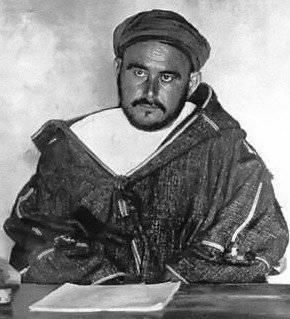
During his anti-colonial activities, he managed to go to a Spanish prison, and in 1919, he fled to his native Reef and there he headed his native tribe. On the territory of the Rif Mountains, Abd-al-Krim and his associates proclaimed the Rifa Republic, which became the union of the 12 Berber tribes. Abd-al-Krim was approved by the president (emir) of the Rifa Republic.
The ideology of the Republic of Rifa was proclaimed Islam, following the canons of which was considered as a means of consolidating numerous Berber tribes that had been at war with centuries for centuries against the common enemy - European colonizers. Abd-al-Krim hatched plans to create a regular reef army by mobilizing 20-30 thousands of Berbers into it. However, in reality, the core of the armed forces subordinate to Abd-al-Krim was 6-7 of thousands of Berber militiamen, but in the best of times up to 80 of thousands of soldiers joined the army of the Rifa Republic. It is significant that even the maximum forces of Abd-al-Krim were significantly inferior in number to the Spanish expeditionary force.
At first, the Berber reefs were able to actively resist the onslaught of the Spanish troops. One explanation for this situation was the weakness of combat training and the lack of morale of a large part of the Spanish soldiers who were called to the villages of the Iberian Peninsula and were sent to fight in Morocco against their will. Finally, the Spanish soldiers, who were being transferred to Morocco, found themselves in alien geographical conditions, among the hostile environment, while the Berbers fought on their territory. Therefore, even numerical superiority for a long time did not allow the Spaniards to prevail over the Berbers. By the way, the Reef War was the impetus for the emergence of the Spanish Foreign Legion, which took as its model the model of the organization of the French Foreign Legion.
However, unlike the French Foreign Legion, in the Spanish Legion only 25% were not Spanish by nationality. 50% of the legion’s military were from Latin America, who lived in Spain and served the legion in search of earnings and military exploits. The legion’s command was entrusted to a young Spanish officer, Francisco Franco, one of the most promising soldiers, who, despite his 28 years, had almost a decade of service in Morocco. After being wounded, at the age of 23, he became the youngest officer in the Spanish army, who was given the rank of major. It is noteworthy that the first seven years of his African service, Franco served in the units of the "regularas" - the Spanish light infantry corps, whose private composition was recruited from among the Berbers - the inhabitants of Morocco.
By 1924, the reef Berbers managed to win back a large part of Spanish Morocco. Under the control of the metropolis only long-standing possessions remained - the ports of Ceuta and Melilla, the capital of the protectorate of Tetouan, Arsil and Larache. Abd-al-Krim, inspired by the successes of the Republic of Rifa, proclaimed himself the Sultan of Morocco. It is indicative that at the same time he declared that he was not going to encroach on the power and authority of the nominally ruled Sultan of the Alauit dynasty of Alawitov at that time in French Morocco.
Naturally, the victories over the Spanish army could not but sway the reef Berbers into thinking about the liberation of the rest of the country under French protectorate. Berber militiamen periodically began to attack French posts, to invade the territories controlled by France. France entered the Reef War on the side of Spain. The combined French-Spanish troops reached the number of thousands of people in 300, and the commander was Marshal Henri Philippe Potente - the future head of the collaborationist regime during the years of the Nazi occupation of France. In the city of Ouarg, French troops inflicted a serious defeat on the Reef Berbers, practically freezing down the capital of Morocco, the city of Fez, from the capture of Abd al-Krim by troops.
The French had incomparably better military training than the Spaniards, and had modern weapons. In addition, they acted decisively and sharply in the positions of the European power. The role played by the use of the French chemical weapons. The mustard gas bombs and the landing of 300,000 French-Spanish troops did their job. 27 May 1926, Abd-al-Krim, in order to save his people from final destruction, surrendered to the French troops and was expelled to the island of Reunion.
All the numerous Spanish prisoners of war who were held captive by Abd-al-Krim's troops were released. The Reef War ended in victory for the Franco-Spanish coalition. Subsequently, however, Abd-al-Krim managed to move to Egypt and live a long enough life (he died only in 1963), continuing to participate in the Arab national liberation movement as a publicist and head of the Arab Maghreb Liberation Committee (existed until independence Morocco in 1956 year).
The Moroccan Humberians also took the most direct part in the Reef War, and after its completion were stationed in rural settlements for garrison service, more similar in function to gendarme service. It should be noted that in the process of establishing the French protectorate over Morocco - in the period from 1907 to 1934. - Thousands of Moroccan Gumières took part in the fighting 22. More than 12, thousands of Moroccan soldiers and non-commissioned officers fell to the battlefield and died from their wounds, fighting for the colonial interests of France against their own tribesmen.
The second serious test for the Moroccan parts of the French army was the Second World War, thanks to the participation in which the Gummies gained fame as fierce warriors in previously unfamiliar European countries. It is significant that, before the Second World War, the Gumieras, unlike other colonial units of the French armed forces, were practically not used outside of Morocco.
On the fronts of World War II
The French military command was forced to mobilize the units of the colonial troops, recruited in the numerous overseas possessions of France - Indochina, West Africa, Madagascar, Algeria and Morocco. The main part of the battle road of the Moroccan Gummies in the Second World War was to participate in the battles against the German and Italian troops in North Africa - Libya and Tunisia, as well as operations in Southern Europe - primarily in Italy.
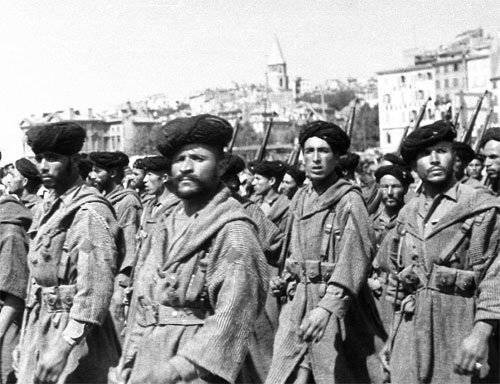
Four Moroccan Gumier groups (regiments) took part in the hostilities, with a total of 12 000 military personnel. Their traditional specializations, reconnaissance and sabotage raids, were left behind the Gummeras, but they were also sent into battle against the Italian and German units in the most difficult parts of the terrain, including in the mountains.
In wartime, each Moroccan group of Gumières consisted of a command-staff "gum" (company) and three "camps" (battalions), three "gum" each. The group of Moroccan camps (equivalent of a regiment) consisted of 3000 military personnel, including 200 officers and warrant officers. As for the "camp", its strength "camp" was installed in the 891 soldier with four 81-mm mortars in addition to small arms. “Gum”, which counted 210 soldiers, was assigned one 60-mm mortar and two light machine guns. As for the national composition of the Gumier units, the Moroccans averaged around 77-80% of the total number of servicemen of each “camp”, that is, they were staffed with almost the entire rank and file and a significant portion of non-commissioned officers.
In 1940, the Gummeres fought against the Italians in Libya, but were then relegated back to Morocco. In 1942-1943 units of the Gumiers participated in the hostilities in Tunisia, the 4 th camp of the Moroccan Gumiers took part in the landing of the allied forces in Sicily and was seconded to the 1 of the American Infantry Division. In September 1943, a part of the Gumières was landed to liberate Corsica. In November 1943, the Gumier units were sent to mainland Italy. In May 1944, it was the Gummeres who played the main role in crossing the Avrunk Mountains, proving to be indispensable mountain shooters. Unlike other divisions of the allied forces, for the Gumières, the mountains were their native element - after all, many of them were recruited for military service among the Berber Atlas and knew very well how to behave in the mountains.
At the end of 1944 - the beginning of 1945. units of the Moroccan Humiers fought on the territory of France against the German troops. 20-25 March 1945, it was the Gumeres who were the first to enter the territory of Germany proper from the side of the “Siegfried Line”. After the final victory over Germany, the Gumier units were evacuated to Morocco. In total, thousands of men passed X-NUMX service in the units of the Moroccan Gumières during the Second World War. With the constant composition of Moroccan units in 22 thousand people, the total losses amounted to 12 8 thousand people, including 018 military personnel (including 1625 officers) killed and more than 166 thousand wounded.
With the participation of the Moroccan Humeres in the fighting in the European theater of operations, including in Italy, they are connected not only with their high fighting efficiency, especially in battles in the highlands, but also with the not always justified cruelty, which also to the civilian population of the liberated territories. For example, many modern European researchers attribute many cases of rape to Italian gums and to European women in general, some of which were followed by murders.
The history of the allies of Monte Cassino in Central Italy in May 1944 is the most famous and widely covered in modern historical literature. After the liberation of Monte Cassino from the German troops, the Moroccan Gummeres, according to a number of historians, organized a massacre in the vicinity, primarily affecting the female part of the population of this territory. So, it is claimed that the Humberians raped all the women and girls between the ages of 11 and 80 over the years in the surrounding villages. Even deep old women and very young girls, as well as male teenagers, did not avoid rape. In addition, about eight hundred men were killed by the Gummeras when they tried to protect their relatives and acquaintances.
Obviously, this behavior of the Gumiers is quite plausible, considering, firstly, the specific mentality of the native soldiers, their generally negative attitude towards the Europeans, especially speaking for them as defeated opponents. Finally, a small number of French officers in the Gumier units also played a role in the low discipline of the Moroccans, especially after the victories won over the Italian and German troops. However, the atrocities of the Allied forces in the occupied Italy and Germany are most often recalled only by historians who adhere to the concept of “revisionism” in relation to the Second World War. Although this behavior of the Moroccan Hummers is also mentioned in the novel “Chochar” by the famous Italian writer Alberto Moravia, a communist who is hard to suspect in an attempt to defame the allied forces during the liberation of Italy.
After evacuation from Europe, the Gummiers continued to be used for garrison service in Morocco, and were also transferred to Indochina, where France desperately resisted Vietnamese attempts to declare its independence from the metropolis. Three "groups of the Moroccan camps of the Far East" were formed. In the Indochina War, the Moroccan Gummeras served primarily in the North Vietnamese province of Tonkin, where they were used to escort and escort military vehicles, as well as to carry out their usual reconnaissance functions. During the colonial war in Indochina, the Moroccan Gummies also suffered significant losses - 787 people died in the fighting, including 57 officers and warrant officers.
In 1956, the independence of the Kingdom of Morocco from France was proclaimed. In accordance with this fact, the Moroccan units in the service of the French state were transferred under the command of the king. More than 14 thousands of Moroccans, formerly serving in the French colonial forces, entered the royal service. The functions of the Gumiers in modern Morocco are actually inherited by the royal gendarmerie, who also performs the duties of garrison service in rural and mountainous areas and is engaged in maintaining order and appeasing the tribes.
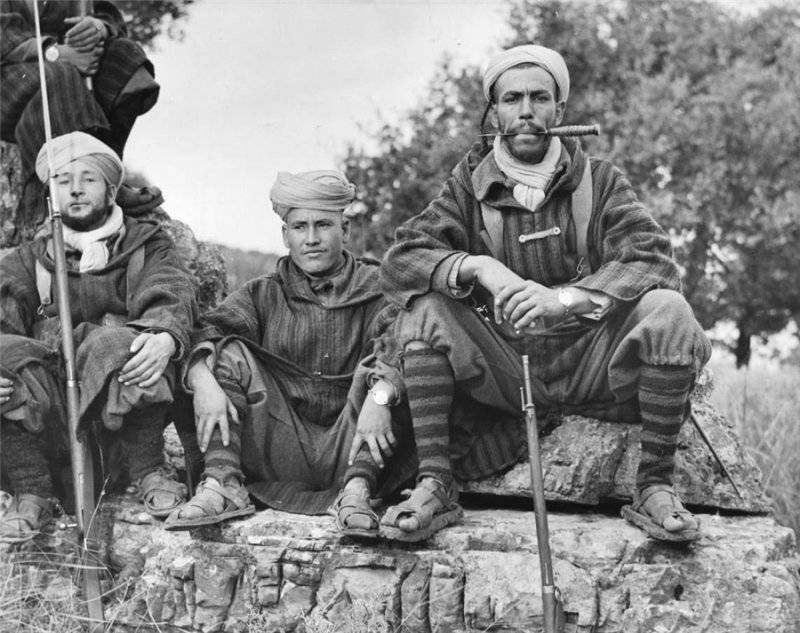
Information